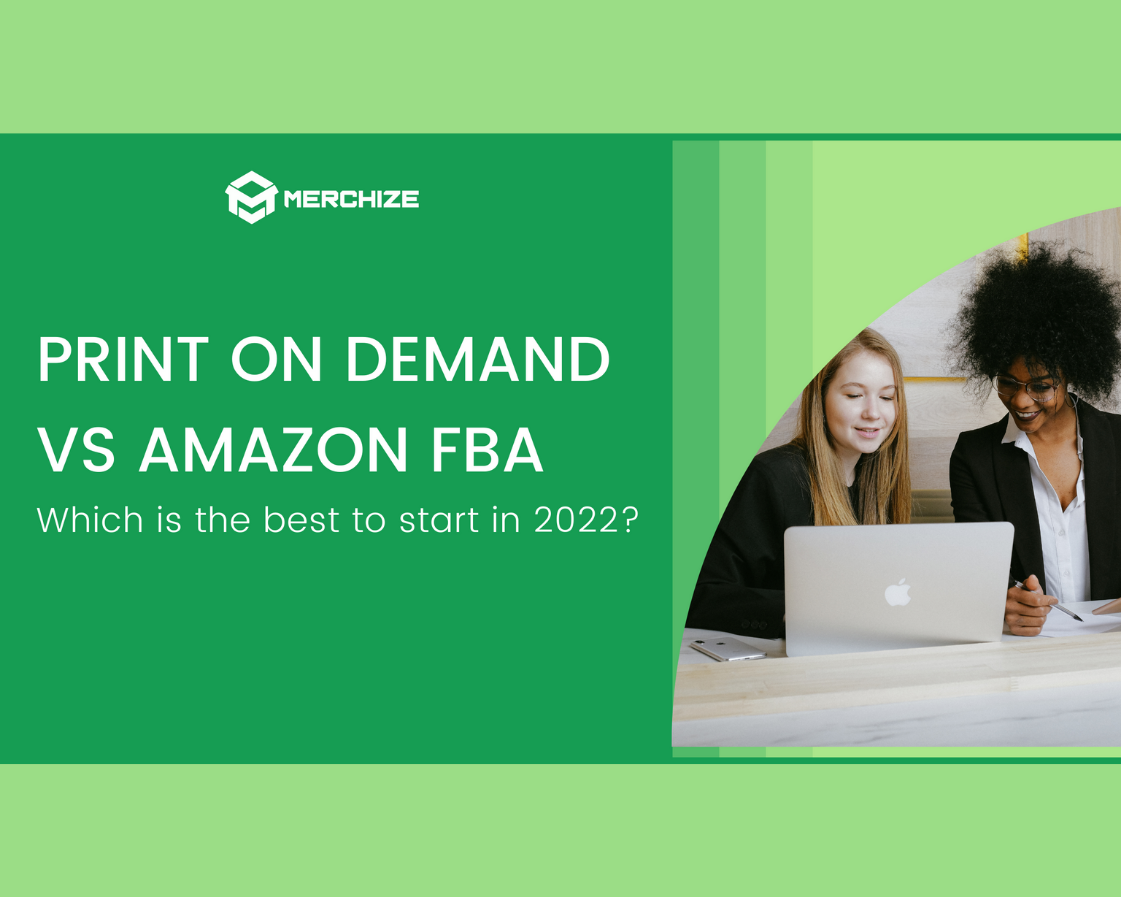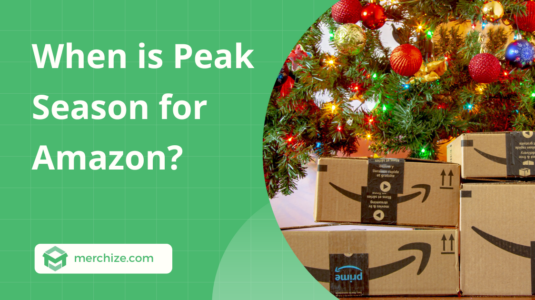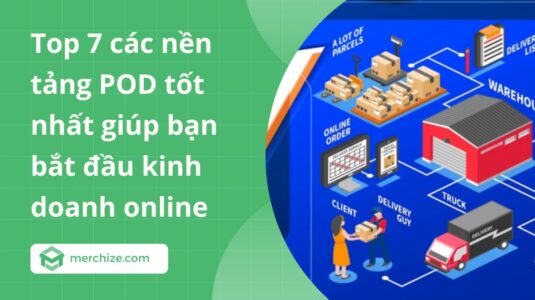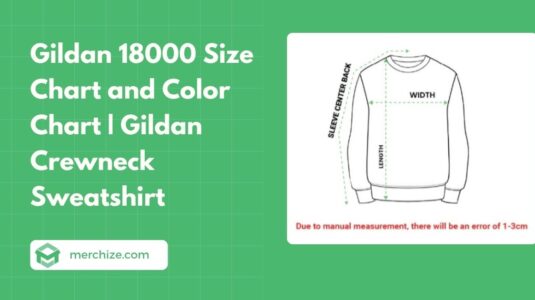Contents
Print on demand and Amazon FBA are the two most helpful eCommerce business methods to focus on if you are planning to build your online business.
What are the differences between Print on demand vs Amazon FBA? Explore the answers in this blog post and you’ll be able to make an informed decision.
Also, you can find some useful tips that help you sell print on demand products on Amazon to boost your sale and expand your business, so do not miss this!
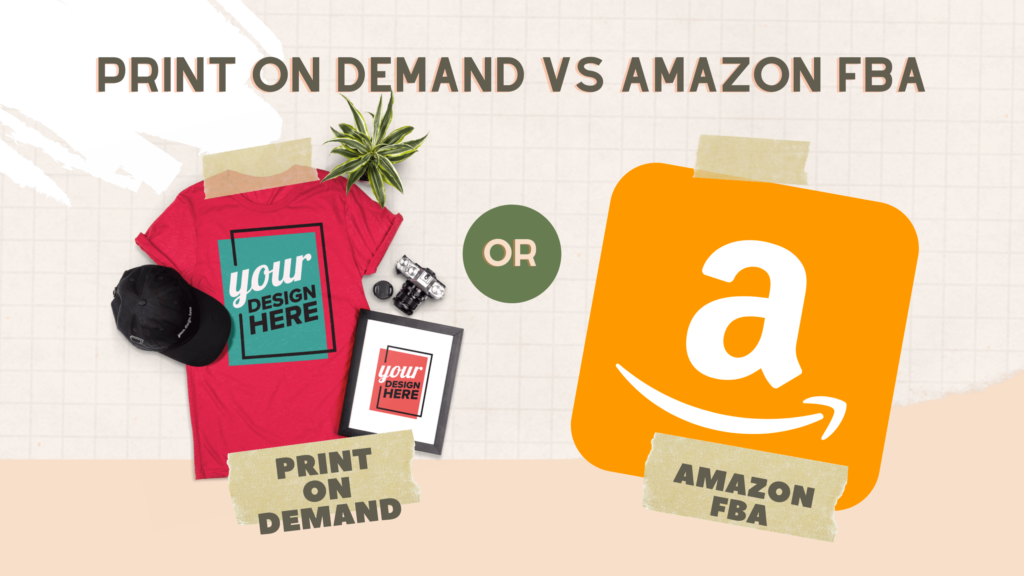
What is print on demand?
Print on demand is a kind of dropshipping model using order fulfillment method where items are printed as soon as an order is made. With print on demand, businesses of any size can easily customize a large number of products and sell them under their brand with their unique designs.

How does print on demand work?
Where can you sell print on demand products?
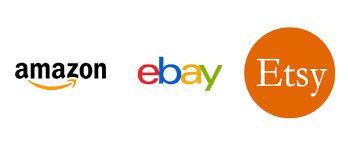
Print on demand platforms such as eBay, Amazon or Etsy let you develop your designs online, set up a shop, reach target audiences and sell without ever having to worry about inventory or shipping.
The integration function from print on demand suppliers just takes a few clicks to connect your online store with a fulfillment partner which allows fulfilling an order after you’ve made a sale quicker to save a lot of time and effort.
Especially, Amazon one of the most popular eCommerce platforms is now offering “Merch by Amazon”, which is an Amazon print on demand service or print on demand Amazon. Merch by Amazon is both responsible for your print on demand platform as well as the fulfillment process.
Simply upload your artwork, select a product type and color, and write a description for your product. Amazon print on demand will establish a product page for you.
When people buy your products, Amazon will print them for you. Amazon print on demand services will take care of production, shipping, and customer service – all without any upfront expenditures.
What is Amazon FBA?
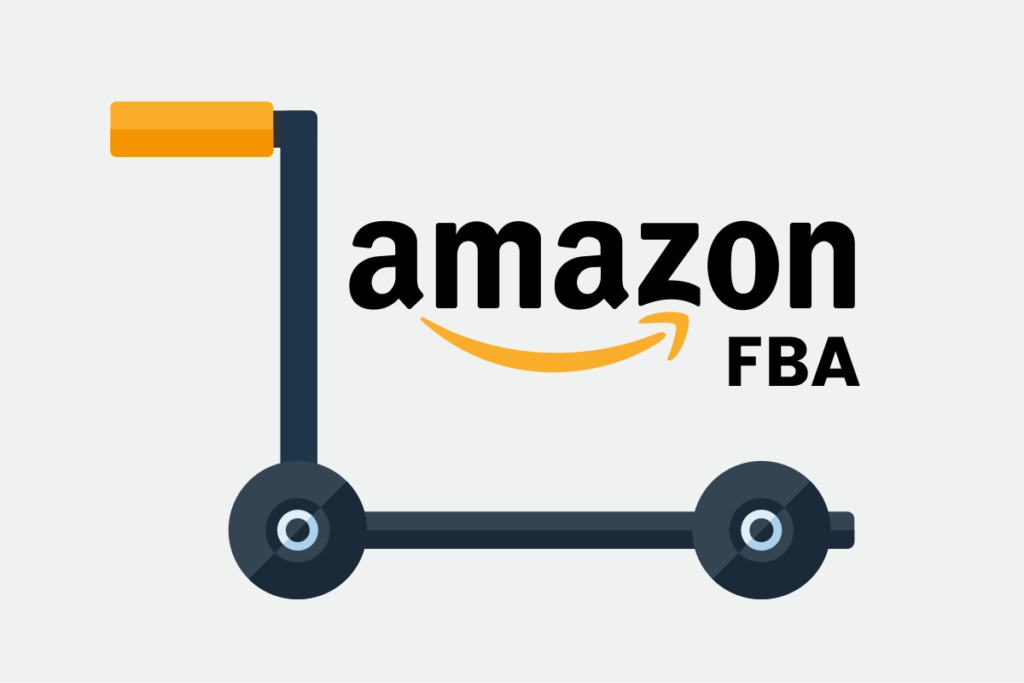
FBA stands for “Fulfillment by Amazon". Amazon fulfillment service provides warehousing and shipping services for your products. Because Amazon is one of the largest markets for many popular products, FBA can save your effort to reach your target audiences.
Your products which follow the FBA program are also eligible for Amazon’s shipping discounts, such as Free Super Saver Shipping and Amazon Prime, which makes FBA even more profitable for sellers.
For entrepreneurs, Amazon’s FBA program is a fantastic opportunity to reach a million customers. It is an excellent online company solution with exceptional scalability.
How does amazon FBA work?
To make it clear and easy to understand about FBA, just put in the following words: “You sell products, and Amazon ships it".
It means that you will list your products, write descriptions and sell it, Amazon FBA will handle all of the storage, shipping, and customer service.
Firstly, as a seller, you will need to find the suppliers and order large quantities of things and send them to Amazon’s fulfillment centers. Once a product is sold, Amazon will pick, pack, and ship it.
Currently, the United States has roughly 100 warehouses. Amazon will advise you where to deliver your items based on the type of products you’re selling once you’ve created the shipment.
Secondly, when your products arrive at the specified Amazon warehouse, warehouse staff will sort them and place them in a storage area. Although losses or broken goods are uncommon, Amazon will pay you if something goes wrong with your items.
Then, when a customer buys your products from the Amazon site, Amazon will track them down and pack them. Your inventory will change as one down automatically.
Amazon would then ship the required item(s) to the customer using the method selected by the customer. Both you and the customer will be able to follow the items along the shipping process.
Finally, other critical areas of the business, such as customer service and returns, would be handled by Amazon. Amazon would provide money for any sales completed through the Amazon FBA mechanism.
Especially, Amazon FBA isn’t just for delivering Amazon’s products. You can utilize FBA to fulfill orders from other e-commerce sites, such as eBay and Etsy, as well as your website.
What are the differences between FBA & FBM?
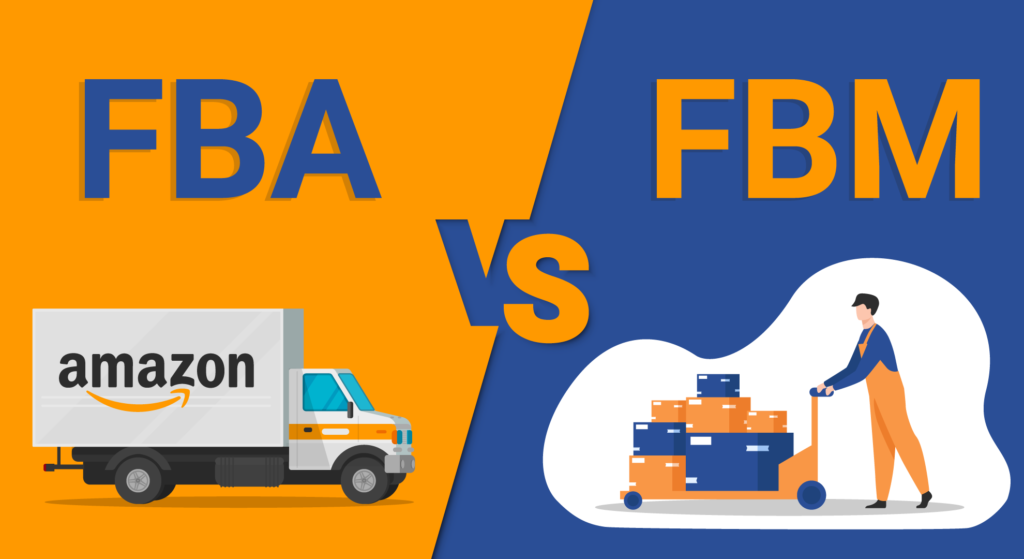
While FBA stands for “Fulfillment by Amazon" meaning Amazon will handle warehousing and shipping services for sellers, FBM (Fulfilled by Merchant) allows Amazon merchants either store and deliver things themselves or outsource fulfillment to a non-Amazon third-party.
As the seller, you would be responsible for Amazon’s shipping and order service criteria. In addition, vendors who use the FBM method must provide customer service and process returns & refunds for all FBM orders.
Merchants can have more control and predictability over their inventory and fulfillment operations thanks to FBM. Sellers who are skilled in logistics and run efficient operations might increase their overall profit margins. When it comes to customer service, sellers also have more control over the consumer experience.
Following FBA program help sellers can gain benefit from Buy Box, which is raising product visibility and thus, help sellers more chances to reach target audiences.
Pro & cons of print on demand in 2023
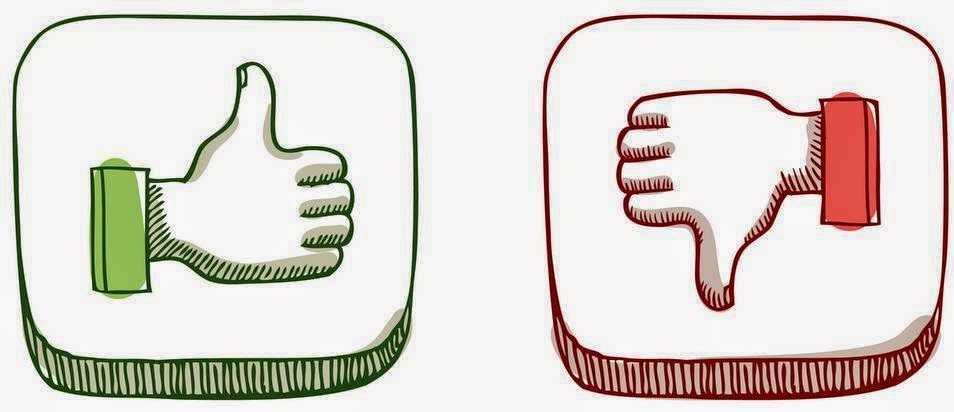
Pros of Print on demand
No upfront costs
Less investment at the beginning
Print on demand doesn’t require a large amount of capital as well as a physical location to start your own business. Simply staying in touch with your suppliers and consumers will allow you to manage your online store efficiently.
It is cost-effective and prevents you from making large initial investments, which can be a significant hardship for many new entrepreneurs.
Time-saving and lower risks
You don’t need to keep a large inventory supply as a print on demand business owner. There isn’t much of a loss if your transaction doesn’t go as planned. The only cost you’ll incur is the cost of setting up and maintaining your internet store.
Otherwise, you can eliminate the need for product packing, shipping, and inventory management. It is an excellent alternative for business owners who want to save time.
Cons on Print on demand
Take a long time to produce and shipping products
Because your print on demand partner only produces the products when the order is placed, so it will take time for manufacturing. Normally, the manufacturing time could be ranging from 1 to 5 days. Then the delivery time will depend on the locations of buyers.
In general, print on demand business will take a longer time for buyers to receive the goods because the product is customized compared to Amazon FBA.
Customer service is your responsibility
Print on demand gives you a lot of flexibility, but you have to rely on the information provided by your print on demand supplier when it comes to answering client questions. It is their product, and you have no way of knowing whether or not they have appropriately described it.
So, you have to make sure that you have selected good quality print on demand suppliers and also be clear about their return & refund policies to provide the best support to your buyers.
Lack of good promotional deals for buyers
Pro & cons of amazon FBA in 2023

Pros of Amazon FBA
Quick delivery & get benefit from Amazon shipping partner
With print on demand, sellers can get a risk of delaying in the production as well as shipment of products. However, with Amazon FBA, now your products are stored in Amazon warehouses around the world and with the best logistics in the world, Amazon can provide the best shipping time for your products.
Otherwise, Amazon has contracts with many big shipping companies that allow sellers who register for the FBA program to provide free shipping for their customers.
On top of that, Prime members get free two-day shipping on all FBA items. This acts as a significant incentive, resulting in a higher sales rate.
Better customer service from Amazon
Using the Amazon FBA program, sellers can get an advantage from their excellent customer service. You might find trouble supporting customers from around the world because of differences in timezone or languages when using print on demand vs Amazon FBA.
With Amazon FBA, you can take benefits from their 24/7 support team via phone, chat or email and they can handle everything for your store.
Save time for SEO & marketing
FBA products frequently appear higher in search results. This increases sellers’ visibility and facilitates sales. Doing FBA also gives the higher chances to own the Buy box which is a box on a product description page where a buyer can begin the purchasing process by adding an item to their shopping cart.
So, sellers can save time & effort on doing SEO and marketing to get traffic to their store compared to doing print on demand.
Cons on Amazon FBA
FBA requires big capital
Amazon FBA will require both storage and fulfillment costs at the beginning. If you want to keep your storage costs down, make sure your inventory moves swiftly.
Before sending the products to the fulfillment center, you’ll have to pay the money up in advance for ordering products in bulk. So, you get a higher risk if you can not compete with other competitors and sell products.
High storage fees
Difficult to find products to sell on Amazon FBA
When it comes to the FBA procedure, Amazon has many specific criteria that must be followed.
Everything must be done correctly, from product preparation to shipping.
All details must be carefully put into Amazon’s database, properly labeled, and then transported to the appropriate warehouses before sending products to Fulfillment centers.
The fact remains that not all items can sell on Amazon and you won’t be able to sell all of the items in your inventory. This is why you must choose your products carefully before sending them to the Amazon Warehouse for FBA.
Tips to become successful with Print on demand strategy and Amazon FBA
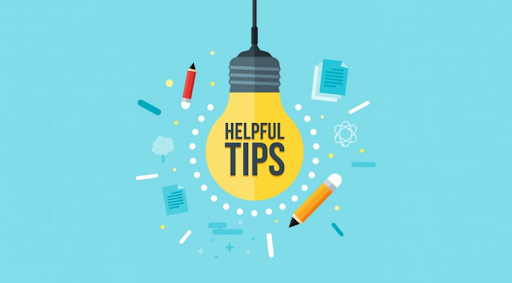
Check the statistic and find the best product to sell with FBA
Do research carefully and keep a watchful eye on your sales figures. Check the traffic (page visit) numbers when you start getting like 2-3 orders from one product. If a large number of people see the product page and orders continue to come in, order the products in bulk and continuously use FBA.
Combine print on demand with Amazon FBA
The fact remains that you can combine Print on demand model with Amazon FBA such as Merch by Amazon or FBM to get advantages from both models. Although Amazon FBA has many perks, not all sellers can adapt to the high investment at the beginning as well as accept a high-risk level.
Besides choosing some of the leading products to register for FBA, sellers can choose to do print on demand method to offer unique & customized products as well as wider the product collection.
Sell print on demand products in different niches
If you follow the Amazon FBA models, the products list is limited following Amazon terms. That means customers’ choices are also limited. However, with print on demand, you have more room to sell different products from various niches then if you find the best niche for you, that’s fine to focus on one or two niches specific.
From clothing to accessories, from home & living to Christmas collection, just make your unique designs and sell them to customers. The more products you have, the more chances you get to reach customers.
Keep adding new products
Customers are always looking for new products and unique ones. Especially, Amazon print on demand products is highly potential to sell if they stick to sales season which could be Valentine’s day, Christmas or Black Friday.
Therefore, you will need to keep your store updated with the market trends, seasonal products and make the products available to customers.
Comparison chart Print on demand vs Amazon FBA
Factor | Print on demand | Amazon FBA |
Costs | Lower cost With no upfront investment, you only pay for manufacturing costs until the order is placed. | Higher cost You will need to buy products in bulk and send them to the Amazon warehouse. That means you have to pay a large amount of money for products and Amazon storage fees. |
Risk | Lower You won’t need to maintain a gigantic inventory stock with print on demand. Only pay for starting your business and marketing. | Higher High investment at the beginning means high-risk level. If the products can not be sold much as your expected, you will lose a lot of money. |
Profit Margin | Lower When it comes to print on demand, there is a lot of competition. Because you do not buy products in bulk, the price could be higher so you have to consider your profit and product’s pricing at the same time. | Higher You can offer your products at greater prices on Amazon if you can’t sell them for a fair profit margin on your website. Once again, Amazon and its brand image deserve all of the credit. |
Traffic | Smaller For print on demand model, you will have to do marketing by yourself to get traffic to your website or products page. This sometimes takes a lot of your time and effort to reach your audiences. | Larger One of the advantages of Amazon FBA is you can receive a Buy box from Amazon. That feature will help you boot your product visibility and reach more customers without running advertising |
Average time for producing, packaging & shipping | Longer If customers place an order for a print on demand product, their waiting will include manufacturing time plus shipping time which could take from several days to several weeks. | Shorter For the FBA program, products are available in warehouses around the year. Thus, with great logistic service, Amazon can ship them to customers in a shorter time compared to print on demand. |
Customer Service | Handle by seller | Amazon customer service |
Return & Refund | Handle by seller & POD partner | Amazon |
Suitable goods to sell | Wider You can sell a wide range of products categories from clothing, home & living to accessories and other items. | Limited Your products and their packaging need to follow Amazon terms and policies. Not all products can be sold on Amazon. |
Faq about POD & Amazon FBA
What’s better: Print on demand vs Amazon FBA?
If you’re just getting started with your online business & have a tight budget, it is better to start with a print on demand business. In comparison to Amazon’s FBA program, print on demand offers additional benefits to entrepreneurs with lower risk.
If you already have an online business and want to expand & get more profit, Amazon FBA is the way to go.
What is the biggest difference: Print on demand vs Amazon FBA?
The biggest difference between Print on demand vs Amazon FBA is stock ownership. You don’t own any merchandise when you do print on demand, and you play as a middleman between print on demand suppliers and buyers.
Using Amazon’s FBA program, on the other hand, requires you to invest in merchandise and keep it in Amazon’s warehouse. In exchange, Amazon will handle all of your shipping and returns as well as customer service.
